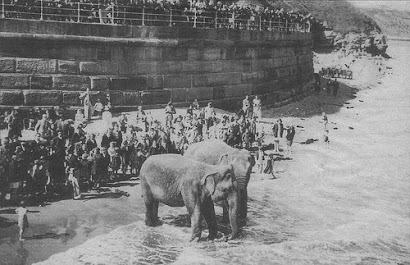ELEPHANTS ON WHITBY BEACH

Sunday, 28 November 2010
FRESH DOWN
Sunday, 21 November 2010
BIRDSONG FROM DALBY FOREST
Gill Catton posted this analysis on the Wild About Britain bird forum...
As well as the robin's gorgeous atmospheric singing there are two crows contact calling and a wren alarm calling (the rattling) which becomes two birds alarm calling. Obviously something's upset them. A great spotted woodpecker with a 'chip' call (01:10). Goldcrests with seeep seeep call (might be a treecreeper - they have a similar contact call). Then a wood pigeon comes in and a robin's alarm call can be heard (the tic tic itc call).
At 4:36 lots of swallow alarm calls.
Coal tit calls.(05:50 and just before). Then a chaffinch call (06:08) - some early on too but this one is clearest.
At least 2 if not 3 territorial robins.
Tuesday, 9 November 2010
DESIRE LINES
BY RICHARD LOCKER

Footpath to Ruswarp
The French philosopher Gaston Bachelard first coined the phrase ’Desire Lines’ in his 1958 book 'The Poetics of Space'. Expressed as 'a term in landscape architecture used to describe a path that isn’t designed but is rather worn away by people finding the shortest distance between two points'.

It is considered that the perfect desire line is a well worn path that either runs parallel with an existing footpath or one that diverges from the said path only to intercept it later, usually shortening the length of the journey. It could be said that each one of the paths represents a subconscious desire to rally against the strictures of conformity and the town planners bludgeoning slide rule or maybe it’s the simple fact that it’s the most natural and obvious route from point A to point B.

I have vague recollections that as a child I was seemingly able to navigate the whole town using these secretive and endless dusty highways, never actually having to set foot on tarmac or concrete at all. But it appears that over the years the majority of these paths have gradually vanished, either through dereliction of use or as sometimes occurs, the local authority has actually taken heed of the lumpenproletariat’s wilfulness, and turned the paths into legitimate rights of way, although it has to be said that these apparently random acts of assimilation do go some way to ruining the enigma of what these dusty old dirt tracks actually represent.

Two former desire lines, now public footpaths




